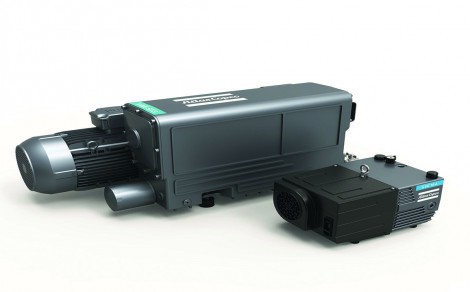The right vacuum pump for your application

By Richard Oxley, vacuum product manager for Atlas Copco UK.
In the past industrial vacuum pumps were synonymous with high oil carryover, excessive noise and prohibitive energy costs. In parallel with developments in other air movement technologies, vacuum pumps have recently undergone substantial advances in terms of reliability, performance, quiet operation, and energy economy.
To assist end users in selecting the best type of equipment for their application, here is a brief overview of the operating principles and current developments in the four main categories of industrial vacuum pump.
Rotary vane
Operating on the simple principle of centrifugal force acting on an eccentrically mounted rotor with radially movable blades, this tried and tested technology has been subject to a host of design innovations to improve performance and reduce total operational costs.
Compared with earlier generations, power demand at the same volume flow is now about 15% lower. In general, the latest units are more compact, with vibration levels that are 3 to 5 dB(A) quieter than their predecessors. They can also now operate at lower temperatures, which protects oil consistency and extends service life as well as maintenance intervals.
The reliability of these ubiquitous machines is attributable to their basic, sturdy construction and good oil retention at all operating pressures. In the latest designs, the pumps incorporate internal injection channels. This reduces the number of gaskets and the amount of external piping required. In some cases, the number of components has been reduced by as much as 20%, further minimising the risk of leaks and subsequent failures.
Capable of an ultimate pressure between 0.1 and 0.5 mbar, rotary vane vacuum pumps are suitable for packaging, woodworking, plastics, paper and printing, material handling and other demanding applications.
Liquid Ring vacuum is regarded as the optimum technology for handling extreme vapour loads and pumping wet or dry gasses with a high tolerance for liquid carryover, especially on condensable processes such as distillation, drying and evaporator duties. Single stage pumps have very good efficiency above 200 mbar and are ideal for general process applications such as filtration and dewatering, pump down or evacuation duties.
Liquid ring pumps are equipped with a fixed blade impeller, located eccentrically within a cylindrical casing. As the impeller rotates, liquid (usually water) is thrown out by centrifugal force to form a liquid ring around the circumference of the casing. This seals the tips of the impeller and creates separate enclosed gas chambers between each blade. In general, capacities range from 170 to 37,500 m³/h.
Dry Claw vacuum pumps offer the advantage that there is no lubrication in the main pumping chamber, which eliminates the possibility of any contamination of the application process.
These types of vacuum pump employ two claw-shaped rotors running in opposite directions that don’t touch each other or the pump chamber. This makes them virtually free from wear. They are also among the quietest vacuum technologies; which contributes to an agreeable working atmosphere in a wide variety of dry pumping applications ranging from packaging lines, pneumatic conveyors, and clamping systems for CNC machines, to moulding machines, drying processes, and central vacuum supply systems.
-
PPMA 2025
23 September, 2025, 9:30 - 25 September, 2025, 16:00
NEC, Birmingham UK -
Advanced Engineering Show 2025
29 October, 2025, 9:00 - 30 October, 2025, 16:00
NEC, Birmingham UK










